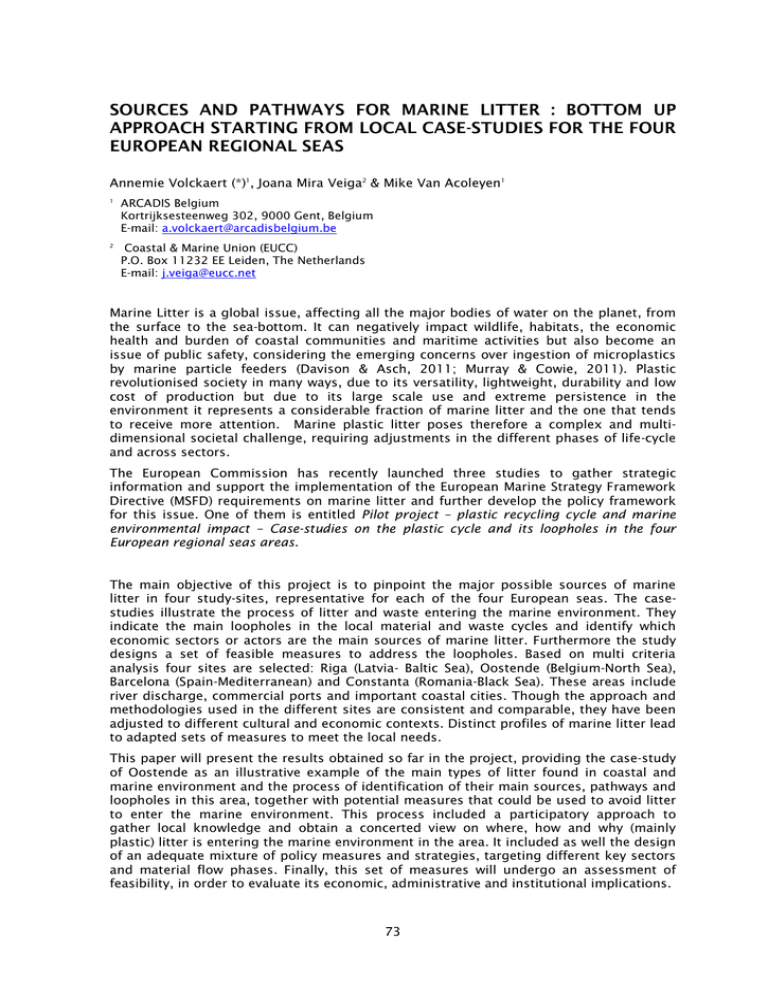SOURCES AND PATHWAYS FOR MARINE LITTER : BOTTOM UP
advertisement

SOURCES AND PATHWAYS FOR MARINE LITTER : BOTTOM UP APPROACH STARTING FROM LOCAL CASE-STUDIES FOR THE FOUR EUROPEAN REGIONAL SEAS Annemie Volckaert (*)1, Joana Mira Veiga2 & Mike Van Acoleyen1 1 ARCADIS Belgium Kortrijksesteenweg 302, 9000 Gent, Belgium E-mail: a.volckaert@arcadisbelgium.be 2 Coastal & Marine Union (EUCC) P.O. Box 11232 EE Leiden, The Netherlands E-mail: j.veiga@eucc.net Marine Litter is a global issue, affecting all the major bodies of water on the planet, from the surface to the sea-bottom. It can negatively impact wildlife, habitats, the economic health and burden of coastal communities and maritime activities but also become an issue of public safety, considering the emerging concerns over ingestion of microplastics by marine particle feeders (Davison & Asch, 2011; Murray & Cowie, 2011). Plastic revolutionised society in many ways, due to its versatility, lightweight, durability and low cost of production but due to its large scale use and extreme persistence in the environment it represents a considerable fraction of marine litter and the one that tends to receive more attention. Marine plastic litter poses therefore a complex and multidimensional societal challenge, requiring adjustments in the different phases of life-cycle and across sectors. The European Commission has recently launched three studies to gather strategic information and support the implementation of the European Marine Strategy Framework Directive (MSFD) requirements on marine litter and further develop the policy framework for this issue. One of them is entitled Pilot project – plastic recycling cycle and marine environmental impact – Case-studies on the plastic cycle and its loopholes in the four European regional seas areas. The main objective of this project is to pinpoint the major possible sources of marine litter in four study-sites, representative for each of the four European seas. The casestudies illustrate the process of litter and waste entering the marine environment. They indicate the main loopholes in the local material and waste cycles and identify which economic sectors or actors are the main sources of marine litter. Furthermore the study designs a set of feasible measures to address the loopholes. Based on multi criteria analysis four sites are selected: Riga (Latvia- Baltic Sea), Oostende (Belgium-North Sea), Barcelona (Spain-Mediterranean) and Constanta (Romania-Black Sea). These areas include river discharge, commercial ports and important coastal cities. Though the approach and methodologies used in the different sites are consistent and comparable, they have been adjusted to different cultural and economic contexts. Distinct profiles of marine litter lead to adapted sets of measures to meet the local needs. This paper will present the results obtained so far in the project, providing the case-study of Oostende as an illustrative example of the main types of litter found in coastal and marine environment and the process of identification of their main sources, pathways and loopholes in this area, together with potential measures that could be used to avoid litter to enter the marine environment. This process included a participatory approach to gather local knowledge and obtain a concerted view on where, how and why (mainly plastic) litter is entering the marine environment in the area. It included as well the design of an adequate mixture of policy measures and strategies, targeting different key sectors and material flow phases. Finally, this set of measures will undergo an assessment of feasibility, in order to evaluate its economic, administrative and institutional implications. 73 References Davison P., Asch R.G. 2011. Plastic ingestion by mesopelagic fishes in the North Pacific Subtropical Gyre. Marine Ecology Progress Series 432:173-180. Murray F., Cowie P. 2011. Plastic Contamination in the decapod crustacean Nephrops norvegicus. Marine Pollution Bulletin 62(6):1207-17. 74






